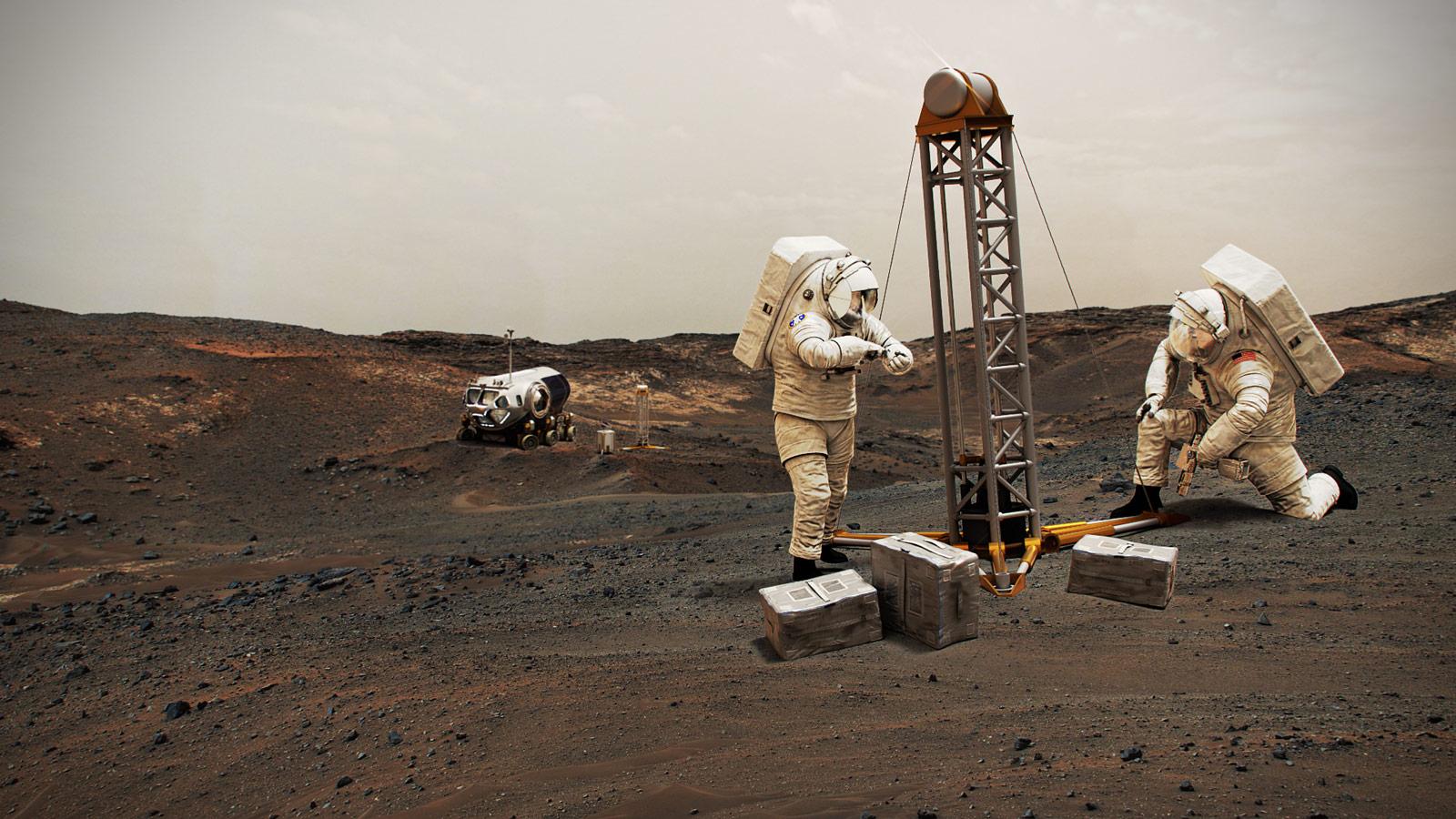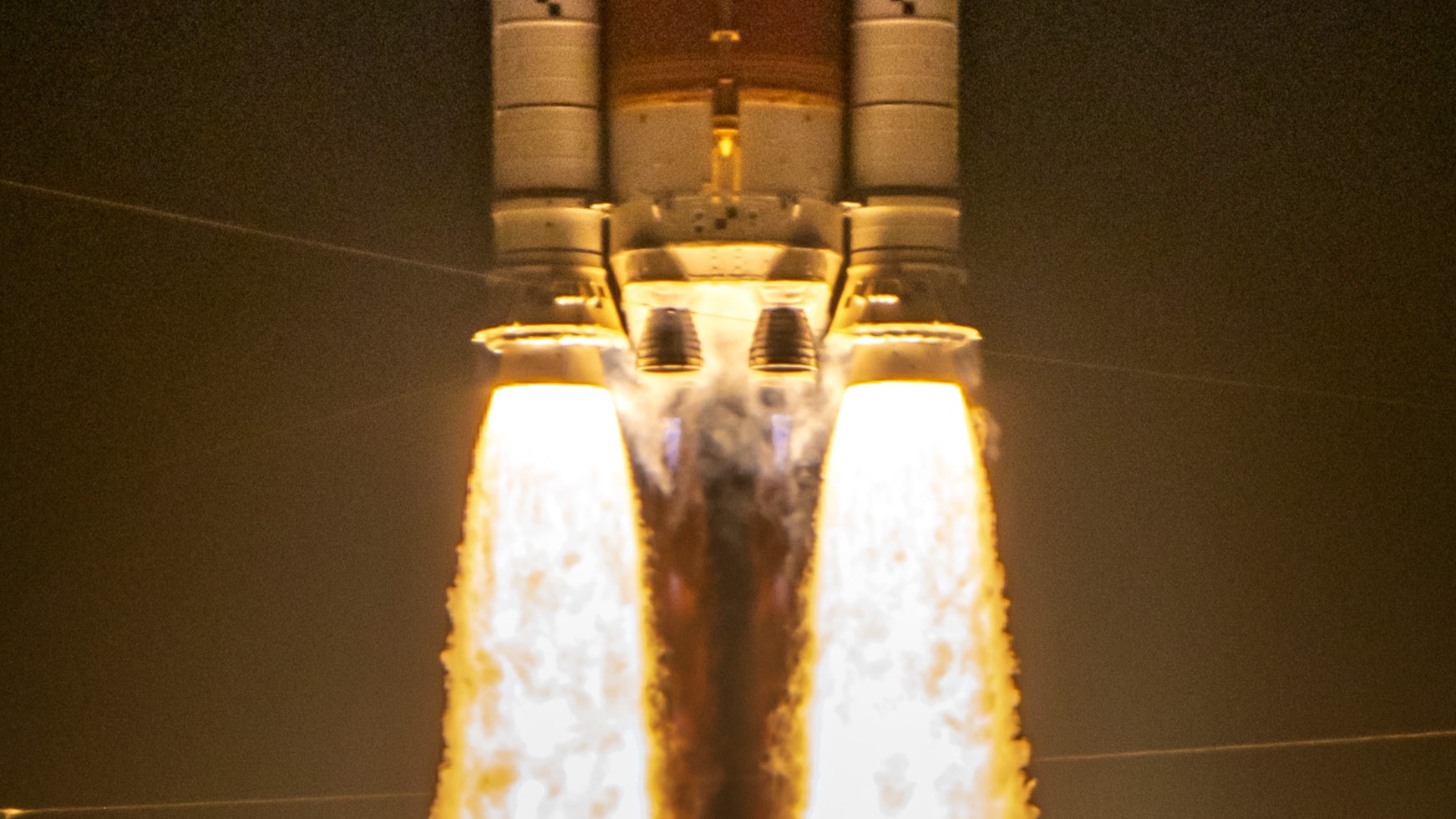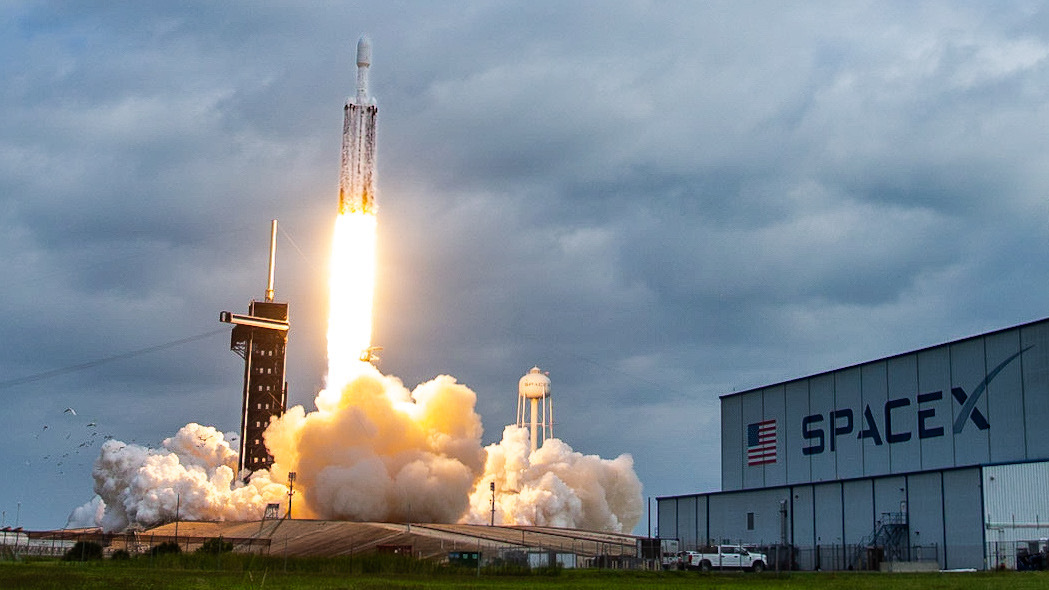
This article was originally published at The Conversation. The publication contributed the article to Space.com's Expert Voices: Op-Ed & Insights.
Since Donald Trump’s recent electoral victory, rumors and speculation have circulated that NASA’s giant moon rocket, the Space Launch System (SLS), could be under threat. The rocket is one of several key elements needed for the US space agency’s Artemis programme, which aims to return humans to the moon for the first time since 1972.
For the first lunar landing mission, called Artemis III, the SLS will launch four astronauts on NASA’s Orion crew capsule. Orion will then travel to the moon. Once in lunar orbit, Orion will dock with Elon Musk’s Starship vehicle (which has been launched separately). Two astronauts will float into Starship, which undocks from Orion and travels down to the lunar surface.
After walking on the moon, the two astronauts return to lunar orbit in Starship, which docks with Orion. The two moonwalkers rejoin their crewmates and go home on Orion, leaving Starship in orbit around the moon.
The US space journalist Eric Berger recently posted on X: “To be clear we are far from anything being settled, but based on what I’m hearing it seems at least 50-50 that NASA’s Space Launch System rocket will be cancelled.”
Related: NASA begins stacking SLS rocket for Artemis 2 moon mission (photos)
No official announcements have been made. However, such a move could be in line with previous speculation that the Trump administration could gut NASA, forcing it to contract out much of its work to the private companies.
Breaking space news, the latest updates on rocket launches, skywatching events and more!
But could another rocket easily take the place of the SLS? This question goes to the heart of what America wants to achieve amid an emerging 21st-century space race. China has pledged to send its astronauts to the lunar surface by 2030. Unlike the US, China is usually conservative in its estimates, so we can assume deadline slippage is unlikely. Meanwhile, several elements of Artemis are holding up the schedule.

One of these delayed elements is Musk’s Starship, which acts as the lander on Artemis III. It still needs to demonstrate key milestones including refuelling in space and performing a landing on the moon without crew. Some in the space community believe that if China were to get to the moon first this century, it would deal a significant blow to US ambitions in space.
Musk has been brought into the incoming administration as one of two chief cost cutters, aiming to make reductions of up to US$2 trillion (£1.57 trillion) from the federal budget. Some observers have been alarmed by Elon Musk’s closeness to Trump and by comments by the president-elect about shifting focus towards a crewed Mars mission.
These comments seem to mirror the views of Musk, who has focused much of his energy on ambitions to settle the red planet, not the moon. The billionaire has said he wants to send humans on a trip to Mars using his Starship vehicle by 2028 – a timeline that some view as unrealistic.

It was actually the first Trump administration that established the Artemis program in 2017. After initial missions to the lunar surface, the program aims to establish a permanent base where astronauts can learn how to live and work on the moon, carrying out cutting-edge research.
However, the schedule has been slipping. US astronauts were to have landed on the moon this year. NASA now says the first landing, during the Artemis III mission, will not take place until Autumn 2026.
Delays have been introduced by redesigns to spacesuits, problems with Orion’s heat-shield and life support systems and, as mentioned, with Starship. An upgraded mobile launch tower for the SLS has also been plagued by cost overruns and schedule slippage.

Notably, an element that isn’t contributing to delays is the SLS, which performed very well during the Artemis I mission in 2022. Many billions of dollars have already been invested in designing and building the SLS and associated infrastructure at NASA’s Kennedy Space Center in Florida.
NASA says the SLS is “the only rocket that can send Orion, astronauts, and cargo directly to the moon in a single launch”. But its expense has been criticised: each SLS launch is estimated to cost more than US$2 billion (£1.6 billion).
News of delays and technical issues with Artemis have coincided with hugely positive PR for Musk’s SpaceX – especially around its test flights of Starship. This included last month’s feat, where the vehicle’s massive booster stage was caught in a pair of robotic arms as it fell back from space to the company’s launchpad in Texas – wowing space enthusiasts around the world. Unlike many launch vehicles, Starship is designed to be fully reusable. Its cost efficiency could greatly benefit future crewed missions.
Mechazilla has caught the Super Heavy booster! pic.twitter.com/6R5YatSVJXOctober 13, 2024
If the SLS were to be cancelled, could Musk’s Starship replace it? Under this scenario, the SpaceX vehicle could presumably serve both as the launcher to send astronauts on their way to lunar orbit and as the lander to take them down to the surface. This is technically feasible, but would be far from a straightforward, like-for-like replacement. The SLS is already an operational rocket, whereas Starship is still in its testing phase and has key steps still to achieve before astronauts can board it.
Another SpaceX rocket that has previously been touted as a contender to launch Orion is the Falcon Heavy. However, engineers would need to modify both the rocket and procedures for assembly and launch. This would carry many uncertainties, and with it the risk of further, significant delays to the Artemis schedule. This all suggests that there is not a lot of time to make major changes to NASA’s moon program if the US is to get ahead in this 21st-century space race.

Rocket launches require specific designs to meet mission requirements, as well as extensive planning for carrying astronauts, spacecraft and payloads. The aims of Artemis are not just to land astronauts on the moon, but to be able to land in a variety of regions on the lunar surface, including the relatively unexplored south pole.
The planning and development required is hugely complex and ambitious. It remains to be seen whether SpaceX, or any other commercial launch companies, are ready for such a major undertaking and commitment.
With tens of billions of dollars already invested in the SLS, it does not seem economically beneficial to completely scrap the rocket. As indicated by NASA’s willingness to seek an innovative approach and work with commercial companies on future Artemis missions, there could be other ways for commercial space players to get involved.
It’s understandable for the incoming Trump administration to raise questions and query cost models in NASA programs. But it would be advisable for them to carefully consider the trade offs before making decisions with such wide-ranging consequences.
It might fall down to whether the priority is winning the new space race. Whatever goals that the new administration chooses to prioritize or target, it may have to carefully justify that decision to other legislators and to the American public.
This article was originally published on The Conversation. Read the original article. Follow all of the Expert Voices issues and debates — and become part of the discussion — on Facebook, Twitter and Google +. The views expressed are those of the author and do not necessarily reflect the views of the publisher. This version of the article was originally published on Space.com.
Join our Space Forums to keep talking space on the latest missions, night sky and more! And if you have a news tip, correction or comment, let us know at: community@space.com.

Professor Yang Gao is a Professor of Robotics and heads the Centre for Robotics Research within the Department of Engineering at King's College London. She brings over 20 years of research experience in developing space robotics and autonomous systems, in which she has been the Principal Investigator of nationally and internationally teamed projects funded by European Space Agency (ESA), UK Space Agency, UK Research Innovation, Royal Academy of Engineering, European Commission, as well as industries. Yang is also actively involved in design and development of real-world space missions such as ESA ExoMars, Proba3 and VMMO (lunar ice mapper), UK's CLEAR, MoonLITE and Moonraker, and CNSA Chang'E3. Yang's work has been applied to several non-space sectors including nuclear, utility and agriculture through technology transfer and spin offs.
Yang is an elected Fellow of Institute of Engineering and Technology (IET) and Royal Aeronautical Society (RAeS). She was named by the Times Higher Education in 2008 one of ten UK’s young leading academics making a significant contribution to their disciplines, and she also received the Mulan Award in 2019 for her contributions to science, technology and engineering. Within her research field, Yang serves the international R&D community through various leadership roles, such as being the Editor-in-Chief of Wiley’s Journal of Field Robotics, the Co-Chair of IEEE Robotics & Automation Society’s Technical Committee on Space Robotics, and the Mentor of the United Nations’ Office for Outer Space Affairs (UNOOSA) Space4Women program, etc.
Prior to joining King's in August 2023, Yang spent nearly 19 years at the University of Surrey where she founded and led the multi-award winning STAR LAB (Space Technology for Autonomous & Robotic systems Laboratory). Before that, she was an awardee of the prestigious Singapore Millennium Foundation Postdoctoral Fellowship and worked on intelligent and autonomous vehicles. She gained the B.Eng. (First Class Honours) degree and Ph.D. degree from the Nanyang Technological University, Singapore in 2000 and 2003 respectively.
-
George² SLS is DOA by design. Assembled with components from the 1960s, with minor improvements, if they can be called improvements at all.Reply -
Unclear Engineer This article seems to miss the main point that Artemis already is dependent on the success of StarShip (or perhaps a Blue Origin competitor) for the actual landing on the lunar surface.Reply
So, if StarShip cannot be made available in time, Artemis is not going to be ready in time.
From the perspective of supporting a lunar habitat for an extended duration, a successful StarShip program seems likely to be far more affordable than a successful SLS program.
So, it we want to "win the race" we definitely need to get StarShip into fully operational mode as quickly as possible.
And if we want to be cost-effective, I seems that StarShip is the less expensive alternative, IF it can actually do rapid turn-around of reusable launch vehicles and can succeed in refueling in weightless conditions.
So, even if it doesn't "win the race", it still seems to be the practical option.
The only other option would be to use SLS and a Blue Origin lander, which seem even less likely to "win the race" and more costly for continued use.
I don't blame NASA for this predicament. I blame Congressional budgeting decisions and shifting levels of support from successive Presidents. -
FireNWater If you can only launch SLS once every 2 years, and the engines aren't being produced anymore what's the point?Reply
.
Just call SLS what it is - a welfare program for Boeing engineers and a vote purchasing program for northern Alabama.
.
Cancel it and give the money to Space X.
. -
edfran ReplyAdmin said:Since Donald Trump’s recent electoral victory, rumors and speculation have circulated that NASA's giant moon rocket, the Space Launch System (SLS), could be under threat.
Trump may cancel NASA's powerful SLS moon rocket – here's what that would mean for Elon Musk and the future of space travel : Read more
TIME TO KILL ARTEMIS-SLS-ORION?Artemis is a NASA program with the goal to “land a woman and person of color on the Moon”.
A single mission will cost over $4 Billion!
$4 Billion goes to the ocean on each launch; nothing in Artemis is reusable.
If program continues, NASA will have to build new engines; currently, SLS uses leftover Shuttle engines.
NASA’s new Artemis launch tower will cost over $3 Billion.
At the current pace, it will consume $200 Billion to repeat the Apollo Moon landings that took place over 55 years ago.
Reality: Artemis is a jobs program to sustain NASA Manned Spaceflight as the International Space Station winds down.
Our politicians have kept Artemis alive despite cost overruns, years of delays and serious design and quality problems.
NASA and Congress need to stop the madness:Kill Artemis, Orion and SLSKill Boeing StarlinerContinue plan to de-orbit ISS in 2030Downsize NASA Manned Spaceflight groupFocus NASA on robotic explorationPrioritize Mars Sample Return -
George² Reply
That is better(if the tag "s" works). We already are enough good with robotic exploration. This won't save civilization when the Earth's habitability come to end.edfran said:NASA and Congress need to stop the madness:Kill Artemis, Orion and SLSKill Boeing StarlinerContinue plan to de-orbit ISS in 2030<s>Downsize NASA Manned Spaceflight groupFocus NASA on robotic explorationPrioritize Mars Sample Return</s> -
ChrisA Reply
On it's first test flight, it carried a human-rated capule around the moon and it landed back on earth. No other rocet except saturn has done this. Falcon heavy can't and Starship is not even close to being able to carry a test load of concrete to orbit.George² said:SLS is DOA by design. Assembled with components from the 1960s, with minor improvements, if they can be called improvements at all.
Remember that SpaceX had a working "cargo dragon" the needed to be converted to "crew dragon." that "simple" step took them almost a decade. We don't evenhave a "cargo starship" yet. All the tests are with no payload, not even with concrete simulated payloads. nd then it will take another decade to huma-rate the ship,just like it did for dragon.
They could do it, but we are talkinglate 2030s at least
You really do need Orion because of the heat shield and launch abort capability. -
Unclear Engineer China has none of those things, now, either, so why would they beat SpaceX if what you say is really the case?Reply -
ChrisA Reply
Canceling it sets the entire moon and mars project back at leat 10 years. It might save money but, you'd loose a decade. SLS is an rational rocket that has alray flown to the moon. Nothjing else is even close to doing this. Do remember how long and what it cost when Spacex converted Cargo Dagon to Crew Dragon. Even SpceX could not do these quickly or cheap. No doubt they could but then you'd be looking at a landing in the 2040sFireNWater said:If you can only launch SLS once every 2 years, and the engines aren't being produced anymore what's the point?
.
Just call SLS what it is - a welfare program for Boeing engineers and a vote purchasing program for northern Alabama.
.
Cancel it and give the money to Space X.
.
The huge problem with Starship is an abort. It is like the Space Shuttle in that if anything goes wrong on launch "everyone dies". All current manned capsules can survive an explosion on the pad, prelaunch or a failed rocket that explodes half way to space. -
Unclear Engineer Chris, at some point the criteria for safety systems for crewed launches will get changed. They were established when explosions on the pad and during ignition of upper stages was not uncommon. But, those probabilities have been substantially diminished over the decades. For instance, when has a U.S. crewed capsule launch been aborted by an explosion on the pad or after liftoff and before achieving orbit? The Challenger disaster is the only one that I can think of. And that did not stop NASA from continuing to use the system. It took the Columbia reentry disaster to seal the fate of the Shuttle program.Reply
I think the bigger issue is going to be what to do about the return trip from the Moon. NASA has always designed for the return to go directly to atmospheric braking, with no retro rocket deceleration. I don't think StarShip is designed for that. I think it would require enough fuel to get reentry velocity down to something more like reentry velocity from LEO. It might even go into LEO and require a crew to transfer to a special reentry craft, with the trans lunar craft being designed without heat shield and landing legs or fins to maximize its efficiency for payload to the Moon. There will eventually probably be such craft serving as tankers to get fuel to the Moon "gateway" orbiter for such specialized trans-lunar crewed craft.
I expect that will all depend on the realities of in-orbit refueling, as we discover them in the development process. -
George² Reply
The problem is that today's engineers do not have and do not want to have real knowledge and skills, because acquiring them requires knowledge in many natural sciences and a lot of mental effort, so as long as the methodologies are recorded in digital form and played on computers, engineers prefer to play like children with sandcastles, which they try until they get something that does not self-destruct. Musk and his fans call it an iterative trial and error approach. The truth is that by working slowly, they receive their solid salaries for a longer period of time than if they did their work in a shorter period of time. Why should I do the work in one year and only receive the salaries for one year, when I can procrastinate and hang around for ten years and even retire within the framework of the project for which I was hired when I was young.ChrisA said:simple" step took them almost a decade.

